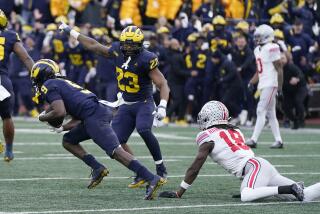Geography of Football Success: Now the Players Go Everywhere
- Share via
DETROIT — Modern college football recruiters have taken all the fun out of life for Ted Goudge.
There once was time when geography played a key role in determining how successful a college football program might be.
A large Nordic population, for example, helped make the University of Minnesota a national football power in the 1930s and 1940s.
In a report to the 81st annual convention of the Assn. of American Geographers, however, Goudge said those days are gone forever.
“Distance doesn’t mean anything anymore,” Goudge said. “College football is big business now and the NCAA Division IA schools have the money to go anywhere to bring in the talent they need.”
Goudge, a professor at Southwest Texas State, is a former collegiate football player himself. He played linebacker for three years at Northwest Missouri after transferring from Army.
He decided to study the relationship between the location of colleges to their long-term football success as a follow-up to a study by John F. Rooney Jr. of Oklahoma State.
In his book “The Recruiting Game,” Rooney pinpoints by county the most fertile high school football areas in the country. States such as Pennsylvania, Ohio, Texas and Michigan turn out a high number of big time college football players, the Rooney study showed.
Goudge found, however, that homegrown talent doesn’t ensure success at the college level.
“On the one hand, there are football programs that have been successful year in and year out that possess good relative locations, such as Alabama, Michigan, Notre Dame, Ohio State, Penn State, Pittsburgh and Texas,” Goudge wrote in his report. “On the other hand, there are sufficient numbers of successful programs with relatively poor locations: Arkansas, Arizona State, Brigham Young, Miami, Nebraska and Washington.”
Goudge’s study included the years from 1952 to 1983.
“Things began to change after 1952,” Goudge said. “That was the year they legalized grants-in-aid and the NCAA took control of television contracts for college football.”
Duffy Daugherty, who coached Michigan State to national prominence in the mid-1960s, helped change the recruiting game forever by building great teams with black players from the South who still were unwelcome at colleges near their hometowns.
“Duffy’s pipeline dried up when Southern schools opened their doors to black players,” Goudge said. “After that, recruiting changed for good. Now, they all recruit the four corners looking for players.”
Goudge admits there may be no surprises in his study. He notes, however, that it might be worthwhile to investigate the importance of tradition to success in the early days and success now. He feels that relationship might be strong.
“It’s a ‘success breeds success’ kind of thing,” Goudge said. “If we can make anything positive there, maybe that will be worthy of a story.”
More to Read
Go beyond the scoreboard
Get the latest on L.A.'s teams in the daily Sports Report newsletter.
You may occasionally receive promotional content from the Los Angeles Times.










